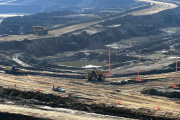Who should pay to reduce emissions from Canada’s oilsands production? More to the point, when it involves investing in carbon capture and storage — a proven technology that, nevertheless, has yet to be scaled up — who should take on that investment risk?
It depends on why you think we need to decarbonize the oilsands in the first place.
For the last three years the oilsands industry group, Pathways Alliance, has touted the achievability of its plan for rapid deployment of carbon capture at a dozen oilsands facilities, connected to a shared carbon pipeline, on their path to net-zero. This is the primary solution the oilsands companies want to use to make their contribution to Canada’s climate targets, and that should be celebrated.
The industry is also aware there is a strong business case for reducing emissions, so their products can compete in a global market that is becoming ever-more interested in low-carbon energy. As our research shows, oilsands bitumen is still some of the most carbon-intensive to produce and refine in the world. Investing in carbon capture, while costly, is an investment in the future of oilsands companies’ business models.
So, if reducing emissions is a business proposition, the way we think about carbon capture investments should be similar to any other large capital investment. Executives spend their shareholders’ money wisely, based on what they know today about how the policy and economic environment is likely to unfold.
What do we know today? For the last couple of years, we’ve known carbon capture investments will be supported by a 50-per-cent investment tax credit from the federal government (which is now a few weeks out from being finalized in parliament), and a 12-per-cent grant from the Government of Alberta.
In addition, the rising price of a tonne of carbon has been fixed until 2030 — meaning companies know the trajectory at which credit values will increase in Alberta’s TIER system, informing the economics of their emissions reduction projects. To further cement these components, the federal government is working on an oil and gas emissions cap-and-trade system, which will provide additional long-term certainty about what emissions reductions are required and on what timeline.
This is a good mixture of subsidies and regulations, ensuring taxpayers’ dollars are well spent and companies are not only being incentivized to reduce emissions, but potentially penalized if they don’t. Our research has found what’s on the table in Canada is generous, even compared with the 45Q tax credit enhanced in the Inflation Reduction Act in the U.S. (where there’s a lot more public money available for the clean economy).
But it’s not up to governments and taxpayers to completely de-risk this. Any business owner will tell you there’s never a guarantee on the rate of return of any dollar spent. It is reasonable, given the momentum of the global energy transition, Alberta’s continued reliance on revenues from this sector that must urgently future-proof itself, and the outsize role that the oilsands play in Canada’s overall emissions, that the sector should take on part of the risk and the cost of these investments.
In other words: It’s now time for oilsands companies to accept the significant level of support on offer.
It’s therefore surprising to hear the new executive chair of Pathways, Derek Evans, continue to suggest that Pathways is asking for more government support to get their project off the ground. It’s even more surprising to hear him say that capturing post-combustion carbon dioxide in low percentages has created challenges for governments, given this has been a known aspect of
carbon capture for decades in heavy industries like oil and gas; the proposed capture process has previously been described as proven and reliable by Pathways; and it is similar to the technology the sector already uses to remove hydrogen sulfide at processing plants, for example.
Pathways has argued for some time they want policy and regulatory certainty before they can move forward. At this late stage, comments like this throw uncertainty into the mix, about a technology and a plan that the oilsands companies have consistently said they have the expertise to implement right now, and calls into question their corporate net-zero pledges.
MC Bouchard is oil and gas program director at the Pembina Institute.







